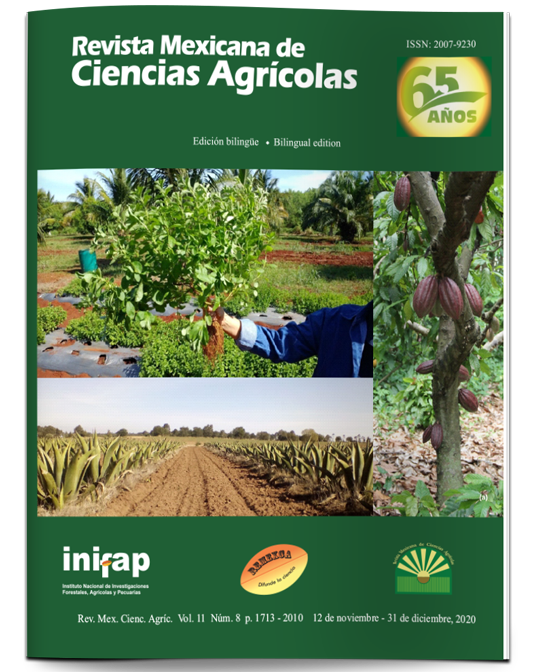Nitrogen availability and biomass yield of Ricinus communis L. fertilized with biosolids
DOI:
https://doi.org/10.29312/remexca.v11i8.2082Keywords:
nitrogen extraction, organic fertilization, plant nutritionAbstract
A criterion to estimate the application dose of biosolids in agricultural soils is the available nitrogen and the requirement of the crop. The objective of the study was to determine the nitrogen availability of two biosolids generated from different treatment systems and its effect on the oil yield from Ricinus communis L. seed. The treatments consisted of three sources of nitrogen (N) and three doses, in addition to a control without N. The sources of N were: ammonium sulfate (SA), biosolids from oxidation lagoons (BLO) and biosolids from activated sludge (BLA). The SA was considered as a commercial witness. The doses of N were 0, 3.79, 5.65 and 7.52 g pot-1, which correspond to 67%, 100% and 133% of the N requirement of the crop (RNC), respectively. The greenhouse experiment was established under a randomized block experimental design with four replications, where the experimental unit was one plant per pot. Nitrogen availability was estimated using the fertilizer equivalency method (EF). The dry matter (DM) was statistically similar between the treatments, being different from the control (p< 0.05). The DM and N extraction showed a quadratic response as a function of the applied N doses. The availability of N was 40.4 and 34.8% for the BLA and BLO, respectively.
Downloads
Published
How to Cite
Issue
Section
License
Copyright (c) 2020 Revista Mexicana de Ciencias Agrícolas

This work is licensed under a Creative Commons Attribution-NonCommercial 4.0 International License.
The authors who publish in Revista Mexicana de Ciencias Agrícolas accept the following conditions:
In accordance with copyright laws, Revista Mexicana de Ciencias Agrícolas recognizes and respects the authors’ moral right and ownership of property rights which will be transferred to the journal for dissemination in open access. Invariably, all the authors have to sign a letter of transfer of property rights and of originality of the article to Instituto Nacional de Investigaciones Forestales, Agrícolas y Pecuarias (INIFAP) [National Institute of Forestry, Agricultural and Livestock Research]. The author(s) must pay a fee for the reception of articles before proceeding to editorial review.
All the texts published by Revista Mexicana de Ciencias Agrícolas —with no exception— are distributed under a Creative Commons License Attribution-NonCommercial 4.0 International (CC BY-NC 4.0), which allows third parties to use the publication as long as the work’s authorship and its first publication in this journal are mentioned.
The author(s) can enter into independent and additional contractual agreements for the nonexclusive distribution of the version of the article published in Revista Mexicana de Ciencias Agrícolas (for example include it into an institutional repository or publish it in a book) as long as it is clearly and explicitly indicated that the work was published for the first time in Revista Mexicana de Ciencias Agrícolas.
For all the above, the authors shall send the Letter-transfer of Property Rights for the first publication duly filled in and signed by the author(s). This form must be sent as a PDF file to: revista_atm@yahoo.com.mx; cienciasagricola@inifap.gob.mx; remexca2017@gmail.
This work is licensed under a Creative Commons Attribution-Noncommercial 4.0 International license.



